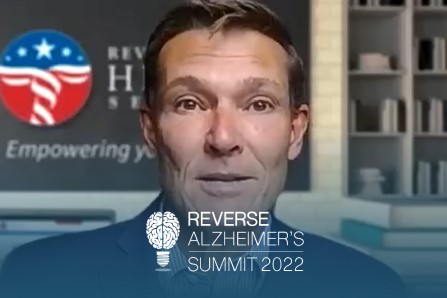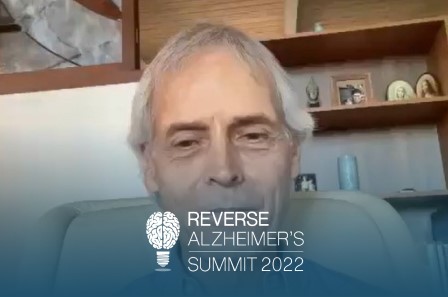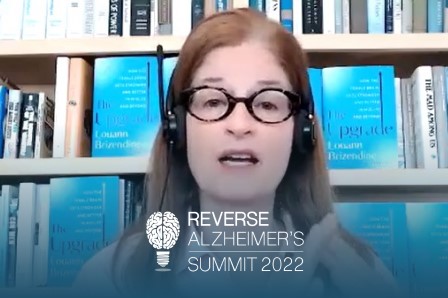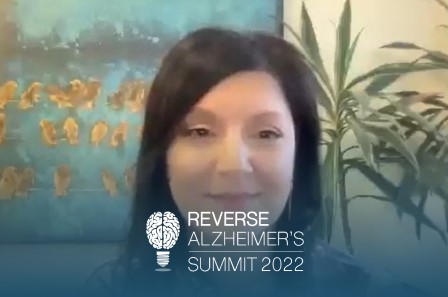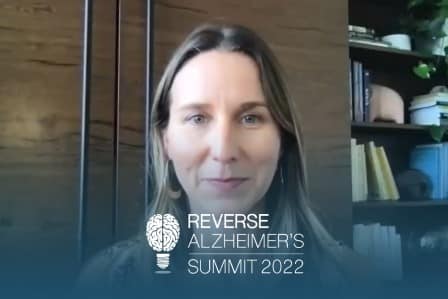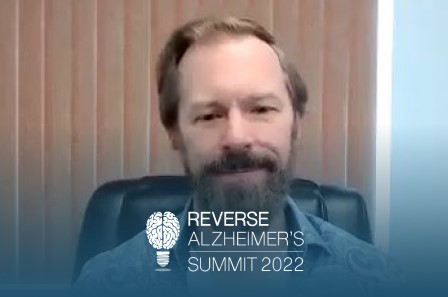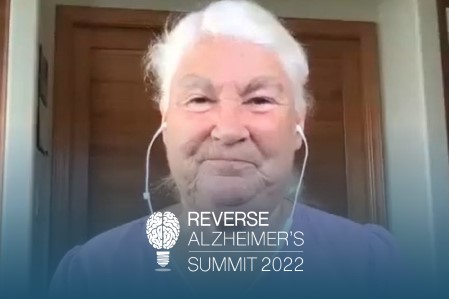Join the discussion below

Dr. Heather Sandison is the founder of Solcere Health Clinic and Marama, the first residential care facility for the elderly of its kind. At Solcere, Dr. Sandison and her team of doctors and health coaches focus primarily on supporting patients looking to optimize cognitive function, prevent mental decline, and reverse... Read More

My Guest is Dr. Chip Whitney is a family physician from Bucks County Pennsylvania, near Philadelphia. After serving time in the United States Air Force and working for the University of Pennsylvania, Dr. Whitney established his practice Revolutionary Health Services in 2004. Preventive medicine has always been his passion, so... Read More
- High risk mouth bacteria that cause bleeding gums also cause Alzheimer’s and heart disease.
- Sleep apnea is not just a lack of CPAP, it is an airway disease that is potentially curable.
- Learn the most important questions to ask your dentist to support your brain.
- Mercury contained in silver fillings is a contributor to Alzheimer’s disease. Find out if need to be removed!
- Learn what you can start doing today to address this important root cause of Alzheimer’s disease.
Heather Sandison, N.D.
Welcome back to the Reverse Alzheimer’s Summit. I’m your host, Dr. Heather Sandison, and I’m so pleased to have my guest today, Dr. Chip Whitney here. He’s a family physician from Bucks County, Pennsylvania, near Philadelphia. After serving time in the U.S. Air Force and working for the University of Pennsylvania, Dr. Whitney established his practice, Revolutionary Health Services in 2004. Preventative medicine has always been his passion. So when he discovered the ReCODE method developed by Dr. Dale Bredesen, he got certified and has implemented the full ReCODE and the PreCODE programs in his practice.
For the past 10 years, he’s been a speaker and writer in dentistry about the effects of oral health on several systemic diseases, inspiring dental professionals to assume the role as complete healthcare professionals. Dr. Bredesen asks that he deliver the high quality, the wonderful lectures, is exactly why I’m having you here today, is because I saw your lectures on oral health and the ReCODE 2.0 training and I was so impressed and really thought it was important that you share with our summit attendees, just how important this often overlooked or under-recognized effect of oral health on cognitive decline. So, Dr. Whitney, thank you so much for taking the time out of your busy schedule to be here to educate our attendees on just this super, super important topic.
Charles Whitney, M.D.
My pleasure Heather, that I mean, it’s just everybody needs to know the mouth matters. The vets got it a long time ago and now physicians and lay people need to understand too.
Heather Sandison, N.D.
I think it’s one of these things that comes up so often I read as people are aging and they’re juggling like, where do I spend my limited resources? I’m on a fixed income, dental work is expensive, it can be out of pocket if you don’t have the right insurance, not everything gets covered by insurances. So how, just briefly, how do you coach patients? When do you say, make this a priority, this is really important.
Charles Whitney, M.D.
Everybody, ’cause it really is. As you’ll hear, as we talk further that it really has a big impact on a lot of disease processes. I mean, we’re talking about Alzheimer’s in this series, but it impacts cardiovascular disease, cancer risk, preterm labor, complications of pregnancy, it’s not just an old person thing. I mean, it impacts potentially everybody. So the mouth really does matter, it’s the gateway to a lot of diseases.
Heather Sandison, N.D.
So here I am talking to a family physician and you are a key opinion leader in dentistry. So how did that happen?
Charles Whitney, M.D.
Some things get dumped in your lap, and this was dumped into my lap. So, I mean, I’ve done preventive medicine for my whole career, back to my air force days. About 10 years ago, I found an implemented a cardiovascular heart attack and stroke prevention program where you can actually prevent that first heart attack and implemented in my practice. Well, it looked at things like biomarkers, blood tests that really reflect as the Cleveland clinic talks about a lot, inflammation in the arteries. And there’s two really important inflammatory markers. One of them is called plaque II.
Basically if it’s not, you’ve got activated plaque in your arteries. And back at the beginning, I was doing, everybody was doing, I was putting them on drugs, I was having an exercise, they were losing weight and this number wasn’t budging. But the second I pulled out those few slides during the about oral health and the training certification program for me, and I started simply having people use a Sonic brush, use a couple of mouth rinses and see their hygienists, that number was plummeting left and right, I mean, it was barely budging even with statin use, which is kind of what at the time of treatment was.
But in lifestyles, but it was plummeting 10 times that amount with oral health. So I was preaching the gospel for a year about oral health and a consensus statement came out between American academy of Periodontology, the gum dentist and the American heart association, trying to tell everybody that there is important connection between the two confused everyone, so I ended up writing an editorial that got published in the dental L’Oreal and that kind of led towards that. But what I really recognized, I had my aha moment when I said, I watched these numbers dropping,
I was like, wait a minute, why is this occurring? I mean, I always have to ask the question why you do I do, that’s what Dr. Bredesen’s practice, methods all about is why is this happening? Well, I caught, you know what, I’ve known for almost 30 years, that if you get bacteria in the mouth from the mouth, whenever you have, biting apple or get the hygiene cleaning done bacteria launch into your bloodstream, and they can infect a disease valve. So that’s why we get antibiotics when people have diseased valves. So I sat back said, well, what else do those bacteria do in health? And that’s where the whole connection of the gum brain, the gum cardiovascular, the gum cancer, the gum preterm provocations of labor, all that, that’s it. When those bacteria that are causing inflammation, that you can see in your gum, hygienists can see your gums, the bacteria, it’s an infectious cause of those bleeding gums that when they land in those end organs, like the brain, the arteries and the organs, they drive that same inflammation and those organs is so simple, but so important.
Heather Sandison, N.D.
So you talked about a marker, so this feels really actionable. If somebody today could go to their doctor and say, can you run this test for me? So what is it again, is it the Lp-PLA2?
Charles Whitney, M.D.
It is, it’s the Lp-PLA2, admittedly people need to recognize most physicians aren’t going to know that test. Places like the Cleveland Clinic, talk about it, but it’s a measure of inflammation that almost always comes from activated plaque in the arteries that doesn’t just have to be done at Cleveland Clinic, but it can be done in quest Labcorp, they run it also.
But again, most physicians don’t know what would exist and don’t know what to do about it because frankly, almost everybody in the 10 years I’ve been looking at this almost about 80, 90% come from mouth and frankly, I think the rest of them come from leaky gut. I’ve had a handful of people over the years where that number just won’t budge, despite great gums, I really think that the other end of the gut got being leaky causes this can do it to also.
Heather Sandison, N.D.
Health starts in the mouth or in the gut and the gut starts in the mouth, right? So, there’s another quick test that I think people could do today at home. And that’s brushed your teeth vigorously, floss, and then spit in the sink and see if there’s blood. Now, you have implored patients, doctors, dentists, everyone involved in your training module with Dr. Bredesen, not to tolerate blood in the sink, tell us why.
Charles Whitney, M.D.
What in the sink by definition there’s a connection of whatever’s in the mouth with the bloodstream. So whatever organisms there and they’re thought to be about a trillion microorganisms in the mouth alone, that they’re getting into your bloodstream, they’re spraying everywhere and causing disease. So whatever’s there is getting in your bloodstream if it’s there and unfortunately way too many health professionals and patients don’t understand the importance of that.
Heather Sandison, N.D.
So, some people might think, well, if I’m vigorously brushing it and I’m poking something around in my gums, of course I’m gonna have blood.
Charles Whitney, M.D.
No, actually that’s not true. I so many people over the years. Oh yeah, if I stopped brushing it or if I stopped flossing, usually the brushing doesn’t do it. But if I stopped the flossing for a while, then I start getting some blood in the sink, well, that’s because you’re allowing the infection to percolate and the infection causes inflammation, Inflammation is what leads to the bleeding. If you do your whole moral health, whatever regimen is recommended by the dentist or your dental team is you’re not gonna get bleeding when you do those things. So I I’ve seen it myself, I got lazy for a bit, and then I started doing things and I start to see a little bit of blood in the sink, and it’s like, oops, there’s my barometer.
Heather Sandison, N.D.
That’s your clue yeah, that’s such a simple test to know that something is going on and that you need to kind of pick up that oral hygiene practice.
Charles Whitney, M.D.
And actually, just to talk about that for just a second too, is that the reason this is important for Alzheimer’s standpoint is they’ve actually found these bacteria from the mouth in the brain of Alzheimer’s patients. I mean, it’s tough to get what’s called causation level evidence, meaning cause effect in health, but most of what we, you and I recommend are based on that, there’s causation level evidence for the bacteria doing that.
And also people have to remember you can’t just rely on your dental team doing it too. Because those back when, what happens is that, when they do their thing with their hygiene and cleaning in the office, and you do your brushing, flossing and maintenance and home, you’re breaking up that biofilm, those organisms want to hide behind in a foxhole, I like to call it going back to my military days. They hide on a foxhole, we have to break them out and let them be exposed to death. Otherwise it can cause problems. Well, that biofilm starts to reconstitute itself within 24 to 48 hours of your hygiene cleaning. It’s quite back to baseline four weeks after your hygiene cleaning. So you cannot just rely on the hygiene team to do their job, you’ve really got to do your job at home too.
Heather Sandison, N.D.
And some people think that there’s well, there is there’s normal flora in the gut and in the mouth. So that normal flourish should be there is that normal flora likes say p gingivalis is the one that we find in autopsy brains that have dementia. Is that normal flora, or is that getting overgrown or is it really just this breakdown in the gum that makes it a problem?
Charles Whitney, M.D.
It’s p gingivalis is probably present in just about everybody. It is the bad boy of bad boys. I mean, it’s the of all the different bacteria we can look at and we do testing for that, and the way I do the ReCODE program, that is the one that drives all three of the above. Heart disease, cancer, and dementia. But anyway, is it there in everybody? Probably, but you wanna keep it in a healthy gums where this biofilm is constantly disrupted, it’s not gonna kind of grow.
So if we just kind of keep it down to a dull roar and keep that Fort Knox of a barrier strong between letting those bacteria into the bloodstream, then it’s not gonna wreak havoc on you. It’s all relative, but yeah, no, so it’s the end, it’s the p gingivalis and the other, what we call anaerobic, the oxygen hating bacteria, they live deep in those pockets you hear about people getting the dentist are measuring. They live deep in those pockets. They hate oxygen and they’re gonna grow more, and that’s what causes the inflammation. So as these bad bacteria colonization that drives the inflammation that drives disease. So I mean everything in life is good versus evil as balanced, so you really wanna kill the bad and promote the growth of the good.
Heather Sandison, N.D.
So are there certain products? I know Dr. Bredesen really likes the dental side in toothpaste, I also recommend that in my clinic, are there a couple of things that are quick and easy to find that you would recommend your patients to use?
Charles Whitney, M.D.
So I have gotten my education from my dental advisors over the years, as you can imagine, I’m not a dentist, I didn’t say in the holiday Inn express either. So, but I got my recommendations them. So I actually asked several dentists that told me the most important intervention they can do for the health of their math is a Sonic toothbrush. Because the Sonic toothbrushes, it vibrates, it doesn’t spin. So when you brush where you use the spinning type of disruption, you’re getting as far as the bristles will go, when you get that Sonic vibration, what it does is to breaks up the biofilm two to three millimeters past the tips of the bristles. So they say, if there’s any one thing a person could do is just using a Sonic toothbrush and Oral-B makes its sonic, Philips Sonicare, those kinds of things you may have heard of.
And the toothpaste there’s a lot of debate on that in terms of, I mean, I’m not gonna comment as a physician too much about that. There’s so many schools of thought, but basically one that causes the least irritation is kind of what I’ve kind of go by, just kind of a plain one or whatever variety. And then mouth rinses, there’s definitely a role for mouth rinses. There’s a little bit of a debate on that, but in my world, just watching it for 10 years now, people in these very specific cardiovascular markers, getting better with the use of mouth rinses, they will kill the bacteria. And then, so they’ll kill a lot of the bad guys, they will kill some of the good guys, and there is some pretty good consensus, they should use kind of mouth rinses without alcohol.
Frankly, I recommend alcohol-free Listerine and another one called the CloSYS, CloSYS, they actually get and I’m not sponsored by them, they together get the floor of the bad guys the best combination I think. Where I have people use Listerine after brushing in the morning and CloSYS after brushing in the evening. And then this is where the dental team can come in is to consider the use of probiotics. So there’s all kinds of regimens out there and on the bottom line, disclaimer is, I don’t know your situation, talk to your dental team. And if is a complete health dental team that knows that mouth body combination real well, that they’ll advise you well on what to do. ‘Cause probiotics if you’re going to kill the enemy, you wanna replace it with good bacteria. So there is a role for providing specific oral problems, the ones you take for your gut don’t work for them. Well, I thought they don’t work. There’s a different mix of good bacteria in the mouth when there is an organ.
Heather Sandison, N.D.
And is there a role for oil pulling? I would love to be sponsored by coconut oil if anybody out there has a connection.
Charles Whitney, M.D.
I’ve never done it myself, disclaimer, people who do it, love it, they’re committed to it. But I’ve had dentists telling me that it does work, it does help to kill the bad bacteria that makes no doubt about it, but it can be cumbersome and complicated, so if people are motivated to do it, it definitely is a valuable intervention.
Heather Sandison, N.D.
Great, now we’ve talked about the gums and that being an avenue for these bacteria to get into the bloodstream. There’s some controversy around this, but it’s a role of root canals versus maybe implants or even fillings, how else can bacteria get into the bloodstream?
Charles Whitney, M.D.
So root canals is a good topic to talk about. So that’s exactly the same way, so what we’ve been talking about is gum bacteria, the gap between your gum and your tooth. So we’re going to have not yet even talked about a tooth problem, we’ve been talking about a gum problem, bad bacteria in the gums. So what happens with the root canal is you get an infection within the tooth, usually there’s like a little crack in the tooth where the bacteria make their way down and get it the base down into the root of the tooth and drive an infection. So again, it’s a bacterial infection typically, or it’s an infectious process that pools infection at the base of the tooth and can get into the bloodstream. +
And if it gets bad enough, that’s when people get pain and need the root canal. So, the what to do about it, there’s definitely debate in there, and the how to treat it, whether it’s with doing a root canal, whether it’s doing a tooth removal and putting an implant in, as a physician, I’m not gonna talk about that, that’s for the dentist too, and there’s a lot of debate within what they should do, but bottom line is you don’t want infection one way or the other, you wanna get that infection out because there was actually a very intriguing study back in 2013, that really linked tightly with we’re talking to cardiovascular disease for a moment, but they looked at 101 heart attacks, and this was actually an American Heart Association Journal circulation, probably heard of that as their top journal American Heart Association, so it wasn’t a dental journal, and they looked at 101 heart attacks, they sucked the clot out of the heart attack, what happens is an artery in the heart, a clot forms in it and they sucked that clot out of the heart and they analyze it for oral bacteria.
And the bottom line outcome of it was that, up to half of those 101 heart attacks, and this is a medical journal, we’re driven by an event from the mouth. It was either, and they’d looked at both gum infection and they look root canal infection and so they were both contributing to that. The interesting part in this discussion is that they did the scan called a cone beam CT scans. It was a very detailed look at the base of the tooth, and they found infections at the base of teeth of these people had heart attack in 30 of those 101 people, every single one of them were asymptomatic. They weren’t having any symptoms of teeth problems that they noticed, so a lot of people can have tooth infections that don’t really bother them, but they can cause problems. So that’s why it really is when your dentist is telling you, you really do need to get this problem that’s not causing pain because a lot of people go in and just fix my pain. Well, what you don’t know will hurt you that those bacteria can get into your bloodstream.
Heather Sandison, N.D.
It’s a good motivation to brush and floss every day.
Charles Whitney, M.D.
The oil filter current, you can pay me now, or you can pay me later, absolutely, that’s that comes with it with the mouth. You either pay with your health or pay with your wallet.
Heather Sandison, N.D.
And this cardiovascular connection, right, of course, we don’t want anybody to have a heart attack or a cardiac event, but the cerebrovascular connection. So when we’re talking about cardiovascular issues, this gets connected to cognitive issues very quickly, because if you don’t get blood flow to your brain, because like the inner layer of your vessels is inflamed, that’s going to affect cognitive function very quickly.
Charles Whitney, M.D.
Yeah, and as the whole reCODE method teaches that, so with the bacteria, we’re talking about toxicity, the bacteria getting into the brain, and we’re talking about cardiovascular type four. And so basically it’s disease of the pipes leading to it. So if you have a, I mean, they’re all the same mechanisms. If somebody has a heart attack, it’s because you’ve got a clot forming in the artery in the heart, a stroke is going to clot forms in the artery, breaks open and ruptures, and the clot floats up to the brain ’cause it’s high pressure vessel. Well, if it happens hundreds or thousands of times, and the itty bitty arteries that supply oxygen to the brain, that’s cardiovascular dementia. So it’s all the same process, just different location.
Heather Sandison, N.D.
Wow, so, so important. So another really important piece of maintaining cognitive function is getting enough oxygen to your brain, particularly at night. So see sleep apnea is a known major contributor to cognitive decline for several reasons. And you call it airway disease. So it’s not just sleep apnea, it’s not just the absence of an CPAP, tell me a little bit more about kind of the comprehensive view of getting oxygen to your brain.
Charles Whitney, M.D.
Yeah, so it’s, and also how it doesn’t necessarily have to have C, so CPAP is like putting a band-aid on a wound. You’re shoving oxygen down the throat you’re going to bypass an obstruction which by just through saw shoving oxygen. So certainly it is an important measure, and some people, if they’ve got severe apnea till they get it fixed. But it’s not treating the problem at all. So the problem with the sleep apnea is that you don’t get oxygen to the brain from a couple of different reasons. So I call it an airway disease because the problem is not a lack of CPAP, like you said, it’s a obstruction either where the tongue falls back into the airway and blocks it off, or they get an upper airway obstruction, it’s usually a more subtle one harder to find. It’s not as ragingly abnormal results on testing, but it can cause a lot of disease coming from the blockages in the nose. So what it’s been, doing speaking in dentistry, I’ve been paired up with a lot of airway conferences and I’ve got to see a lot of very, I’ve been taught tremendously by my dental colleagues about airway disease, because you can actually, and as you saw in the training, there’s physical exam features that you can see on people who have sleep apnea, whether it’s scallop look on the sides of your tongue from gritting your teeth, whether it’s a TMJ, ’cause you’re gritting your teeth and you’re not breathing, there can be really skinny people, and most people think of a sleep apnea as that of the obese and certainly losing weight and will be very helpful, but now that I know what to look for, and I’m looking for it through physical exam features and symptoms, I’m finding a lot of very thin people sleep apnea, and interestingly, it starts very early in life. I mean, it starts in the pediatric population when those bones are all malleable and forming that people are left with a narrow palette, high arch, where they’re very narrow face.
The jaw gets pulled back for various reasons and basically shoves the tongue in the way so that what the dentist are able to do with various techniques are to open up the airway. They guess they can make an appliance, most people know about that, so if somebody has an appliance and they keep spitting it out, just a side note, it’s probably coming from the nose. So I’ve heard dentist say, you’re gonna make a person’s CPAP worse if the problem’s coming from the nose, but you give them an appliance. But they have different ways whether it’s Invisalign or other techniques called Vivos, where it actually both opens the airway and restructures the mouth, but if you can restructure and create more space to breathe, you can cure your sleep apnea and put your sleep apnea on the shelf for memories. So totally it’s actually the dentist team can actually cure the problem in some people.
Heather Sandison, N.D.
A handful of patients do really well with just mouth tape, which when I initially heard about it, I was like, that’s weird, that sounds awful. But people swear by it just putting and again, a very practical intervention, very inexpensive something to just try, the other thing is that those strips that you can the breathe right strips.
Charles Whitney, M.D.
So both of those things are treating that upper airway resistance syndrome, the sleep apnea that’s not coming from the tongue falling in the throat is coming from obstruction in this area and people who are mouth breathers. So for various reasons, some people are mouth breathers and we should be healthy breathing at nighttime as breathing through our nose, so by putting the tape on there forces you to breathe through your nose.
Now that’s a problem if you’ve got a lot of nasal congestion, so interesting and to kind of another, no treating the toxicity of like say mold toxicity that people, and that’s the root cause of it. Your round congestion in their nose goes away and that’s the way they can actually improve their sleep apnea. So they cure their mold and they fix their sleep apnea in some cases. But yeah, so any intervention, whether it’s a, whatever treatment to reduce the swelling at nighttime can be beneficial. So that’s kind of in the treatment regimen is just for people who the upper airway resistance is to whatever non-surgical ways you can to treat the problem is coming from the nasal passage.
Heather Sandison, N.D.
And for anyone here who’s listening that has more questions about the mold toxicity, chronic sinusitis, and how that might be contributing to cognitive decline, both Dr. Joe Krista and Dr. Neil Nathan dive deep into these subjects, so I invite you to go over there, listen to those interviews ’cause there will be lots and lots there to help you find solutions for cognitive decline that can be coming from those chronic sinus infections or mold toxicity, and Dr. Whitney and I are both, those are our colleagues and mentors, and we’ve learned a lot from them and incorporating that into a comprehensive approach to combating cognitive decline is so important. Another piece of the puzzle when it comes to dentistry is the role of potentially mercury in amalgams. So, tell me a little bit about, what’s known, what isn’t, and when someone might consider an intervention there.
Charles Whitney, M.D.
So mercury it’s a known neurotoxin it’s going to, it is a root cause of Alzheimer’s disease. So I and anyone who understands that concept says that nobody should ever have mercury put in their mouth again. There are dentists out there who do it still because it is supported by the American Dental Association. So there’s a lot of controversy in dentistry, so I’m not gonna get into the details of that. But I, as a physician, don’t think anybody should get more mercury put in their mouth, ’cause when you put the mercury in the mouth, you get a lot of mercury exposure.
So, the question is, is that do you have to have, if you’ve like many of us, do you have to have your mercury fillings removed? And the answer is, maybe. Well, one reason is it, so I always tell my patients, if I see mercury in their mouth, I say, go to your dentist, haven’t taken a look at the mercury if the filling is in good repair, you might not have to have it taken out. If it’s breaking down, you’re getting mercury in your system and it should come out, and if it’s done, it has to be done in a safe way. There are stay safe techniques for removing it to minimize your exposure, because the other time you get the most exposure is when you take out the fillings. So when you put them in and when you take them out, you get your most mercury exposure.
So if you’ve got a filling that’s not broken down and it’s not leaking into your system and no harm, no foul, don’t, let’s leave it alone, don’t have the fillings taken out. And there are ways that we can test for mercury toxicity and even help to sort out, is that coming from inorganic sources like the fillings, or is it coming from eating a lot of fish over the years and just not getting it, right? There’s ways you can distinguish that and we can test you for that. So if somebody comes back and the dentist says, yeah, they look like they’re in pretty good shape, then what I’ll do, and the dentist could do also, is to test to see is that getting into the system and does it need to be taken out because it is leaking.
Heather Sandison, N.D.
I had a patient who had a significantly elevated, we had done the test that you’re referring to and she had both that were significantly elevated and she refused to take any supplements. So she wouldn’t do any binders, she didn’t wanna do any sort of chelation in her Iv, she was like, I’m just gonna be honest, I’m not gonna swallow it. So I did advise her to have them removed because those levels were elevated and she came back a year later, it was a full 12 months later and we tested again, it had decreased by more than half. So no intervention other than getting them all out and both the inorganic and methylmercury had both shifted significantly. So she was kind of a control if you will of us because there was no other, the IMD powder, we hadn’t done any EDTA or DMPs or DMSA. So it was just an interesting kind of won.
Charles Whitney, M.D.
Yeah, yeah, and that makes sense because I clearly, whatever dentist took the fillings out, did a good job.
Heather Sandison, N.D.
Yes was a biological dentist.
Charles Whitney, M.D.
Yeah, so that clearly they did a good job on it and there’s definitely evidence that if you’re gonna have a lot better outcome, if you do it in ways that are safe.
Heather Sandison, N.D.
Do you tend to refer to biological dentists or do you think that there is another way to choose a good dentist in your area?
Charles Whitney, M.D.
So, I don’t like to pigeon hole dentists into titles. So it mean a biological dentist is kind of like I’m a functional integrative physician. I mean, I’m a physician and I just have an emphasis on root causes, understanding things like toxicity. So those who are kind of branding themselves as a biological dentist then certainly know, especially from a toxicity standpoint, the concept of mercury. And they are the ones who are most likely to be trained in that, but I’m really more interested in a dentist who just understands the mouth body connection, ’cause there’s a ton out there that’s not necessarily, like we talked about like the oral bacteria, the airway there’s a whole lot.
So there’s actually kind of a term complete health dentist where they’re kind of branding themselves and setting their practice up in terms of complete health where they understand and they talk to people along these fronts about the connection of the mouth and the body and why they should do this and that. And it makes a big difference. I mean the root canal example is a perfect one where it’s like a lot of dentists, if there’s no pain, they leave it alone, but what you don’t know is gonna be hurting you. So, but yeah, I mean, that’s a, if people are looking for a dentist I mean, number one dentists can get certified in the whole Bredesen ReCODE method through Apollo Health, they’re kind of in the very early stages, there’s not lots of them out there right now doing it. but I was that would be a certainly a great place to start if they happen to have somebody in their area who’s been certified in ReCODE .
And then basically kind of looking around to find out if they can see somebody who kind of, I mean, branding themselves, or if you look at their websites and say that they understand the mouth body connection or call themselves complete health dentist or a biologic dentist, and that’s a good starting point. Frankly, the lowest level triage I have for that is that does the dentist tolerate blood in the sink? ‘Cause obviously there’s been many times I as a physician, I say, do you bleed when you brush or you floss? And if they say yes and it’s on my questionnaire, and if they say yes, I say, so what’s the dentist say about your gums? Oh, they say, they’re great, okay. There’s a mismatch right there. And the other thing is that people can look for is does your dentist do testing for your pockets? So where they usually there’s one or two people there, often them hygienist and assistant where they’ll kind of go through and they’ll measure your pockets between your tooth and your gum ad they’ll call out numbers like one, three, five, things like that. If they’re doing that, then they at least understand the basics that that’s an important thing to keep control of and they’re doing so, if your practice isn’t doing the it’s called period charting, and that’s kind of another indicator that it’s not so much a complete health type practice.
Heather Sandison, N.D.
Great, good to know.
Charles Whitney, M.D.
I don’t wanna bet because there’s a lot of great dentists that if you need a root canal, they do a great job at or a crown or whatever, but it’s the acceptance of disease that to no fault of their own, they just don’t understand our world and how much problems it can cause even if it’s not bothering the patient.
Heather Sandison, N.D.
Yeah, we wanna get proactive, particularly if someone already has symptoms of cognitive decline or maybe even when they have a genetics that can predispose them or family history that can predispose them. And as you’ve made a really phenomenal point that same thing with heart disease, if you have a family history or genetic or labs that might indicate that there’s some sort of cardiac risk, making the dentist a priority, making dental hygiene a priority, doing whatever the dentist is recommending, getting that done, it starts to be really high on the list of places to put your resources and put your time.
Charles Whitney, M.D.
Yeah, that’s where we kind of bring us right back to the beginning where it is a significant the mouth, those three areas, the bacteria for root canals and gum problems, the airway problems and toxicities, like amalgams, they’re a root cause of a lot of things. And the big three, I mean three biggies of cardiovascular disease, dementia and even cancer. There’s a lot of special that p gingivalis are pancreatic cancer, esophageal cancer, are definitely a connection between the mouth and those cancers.
Heather Sandison, N.D.
And I would imagine mental health as well, certainly with the mercury. So yeah, lots of connections here. Well, two out of two doctors recommend you go see your dentist.
Charles Whitney, M.D.
Absolutely.
Heather Sandison, N.D.
Doctors…
Charles Whitney, M.D.
The guys who are watching out there, I encourage you to learn more about this and consider getting certified in the whole process too, because it’s honestly, it’s so much fun collaborating with dentists to understand that the dentists who are looking to collaborate with physicians, there are lots of us out there who want to work with you. So I really do encourage the dentists who are watching to really go learn more about it on Dr. Bredesen’s Apollo Health site, there’s you can find out how to learn more about it.
Heather Sandison, N.D.
I feel so fortunate to have a few really phenomenal dentists who are thinking this way in San Diego, and so we chat frequently about patients and collaborate and it is a lot of fun.
Charles Whitney, M.D.
Several in San Diego we may know something.
Heather Sandison, N.D.
We probably know the same ones.
Charles Whitney, M.D.
Yeah, I really do.
Heather Sandison, N.D.
I really feel fortunate to be in a community that has that resource, because I don’t have to skip a beat saying this is the dentist, go see them. They’re close to you, I trust them. They’re gonna give you good advice. And that that’s just so reassuring. Dr. Whitney, thank you so much for being with us. I wanna make sure that everyone knows where they can find out more about you, particularly our East Coast patients, but also online. So share with our listeners how they can get a hold of you.
Charles Whitney, M.D.
Yeah, by practices revolutionary health services. Again, I’m just outside of Philly and it’s rhslivewell.com. Our agent like revolutionhealthserviceslivewell.com. So, kind of the whole approach is it’s a preventative at the core with the ReCODE as the really gratifying opportunities that we have
Heather Sandison, N.D.
And just to be clear, because I know you outside of just this conversation, you do whole health medicine yourself, not just focusing on oral health, but in this context, fewer physician, you are a physician who can help
Charles Whitney, M.D.
Industry I’m a family physician practice. So yeah, now I’m a physician at the core and then people have asked me, did you wish you went to dental school? ‘Cause I talked to, it’s like, no, I just never had any idea how important it was and I want to tell the world, ’cause it’s really important our dental colleagues are critical.
Heather Sandison, N.D.
Your are making that connection and you have the full suite of medical care available. So Dr. Whitney, thank you again.
Charles Whitney, M.D.
My pleasure, my pleasure.
Heather Sandison, N.D.
So nice to see you, so good to see you.
Downloads

